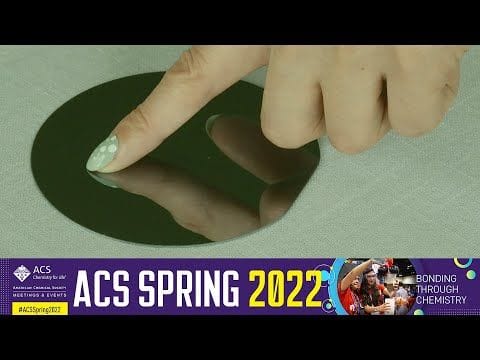The Spring 2022 National American Chemical Society (ACS) meeting held in San Diego, California, was a hybrid meeting that featured a wide range of science topics. The offerings showcased the vast diversity of the chemical sciences and the increasingly integrated nature of the projects. Believe it or not, using touch, people can distinguish between texture […]

Believe it or not, using touch, people can distinguish between texture differences down to one atom. Charles Dhong’s group at the University of Delaware has been investigating the human ability to distinguish different textures by touch. Swapping out one element in a polymer can change the way the molecules line up in the bulk sample, and in polymers, that changes their crystallinity: how orderly they pack together.
These chemical differences can be distinguished using your fingertip in the same way you can feel the difference on the surface of a glass before and after you put it in the dishwasher. Before it goes in, the surface is smooth, and your fingers move over the surface easily. Afterward, it feels rougher, and your fingers don’t move as easily. The same thing happens when atoms are substituted into a polymer and the polymer crystallinity is disturbed: when a polymer is more crystalline, it feels smooth; less crystalline, it feels rough. Dhong’s group is looking at how people perceive differences in touch and how small the differences can be before they become undetectable. Dhong foresses that the applications of this are varied, from better devices, such as braille displays, to providing additional sensory information, to surgeons during remote procedures.
News briefing from the meeting: https://www.acs.org/content/acs/en/pressroom/newsreleases/2022/march/stimulating-the-sense-of-touch-with-chemistry.html
Video media briefing:
Recent American Chemical Society publications on this topic:
Three-Dimensional Self-Healable Touch Sensing Artificial Skin Device
Sulbin Park, Byeong-Gwang Shin, Seongwan Jang, and Kyeongwoon Chung*
Silk Fibroin Nanocomposites with Indium Tin Oxide toward Sustainable Capacitive Touch Sensing Applications
Ander Reizabal*, Nelson Castro, Nelson Pereira, Carlos M. Costa*, Leyre Pérez, José Luis Vilas-Vilela, and Senentxu Lanceros-Méndez
Virtual Environment for Studying the Docking Interactions of Rigid Biomolecules with Haptics
Georgios Iakovou, Steven Hayward*, and Stephen D. Laycock
Haptic-Assisted Interactive Molecular Docking Incorporating Receptor Flexibility
Nick Matthews, Akio Kitao, Stephen Laycock*, and Steven Hayward*
Recent publications by this group:
Interfacial Drawing: Roll-to-Roll Coating of Semiconducting Polymer and Barrier Films onto Plastic Foils and Textiles
Rory Runser, Samuel E. Root, Derick E. Ober, Kartik Choudhary, Alex X. Chen, Charles Dhong, Armando D. Urbina, and Darren J. Lipomi*
Optics-Free, Non-Contact Measurements of Fluids, Bubbles, and Particles in Microchannels Using Metallic Nano-Islands on Graphene
Charles Dhong, Samuel J. Edmunds, Julian Ramírez, Laure V. Kayser, Fang Chen, Jesse V. Jokerst, and Darren J. Lipomi*
